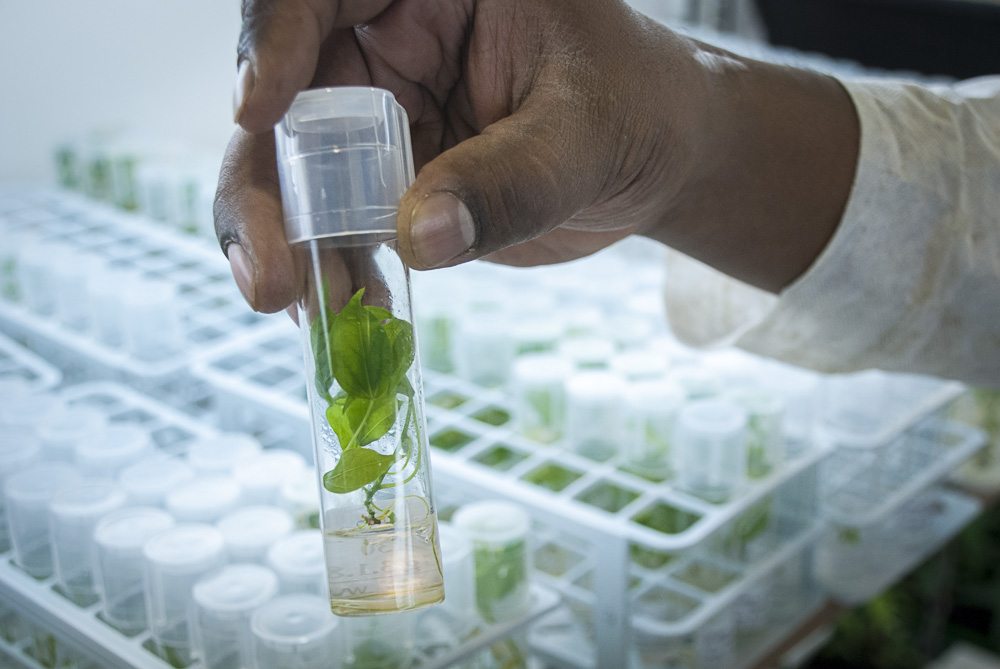
Scientists from the Natural Resources Institute of the University of Greenwich have developed a procedure for eliminating virus infections from cassava.
Cassava is a tuberous root crop that provides food for more than 200 million people in sub-Saharan Africa. Cassava is important because it can be grown all year round and provides valuable food in periods when other food staples are not available. Its edible, starchy roots are a major source of carbohydrate, and it is better equipped than many crops to resist the effects of climate change as it can withstand drought and grow well in poor soils.
All these benefits of cassava have been threatened by two devastating viral diseases; cassava mosaic disease (CMD) and cassava brown streak disease (CBSD) that constantly undermine cassava from reaching its maximum potential in eastern and central Africa. CMD and CBSD together cause losses of up to US$1 billion a year in Africa, and at the farm level they can cause total loss of the crop, with potentially devastating consequences for those who rely on it as a major source of food. CBSD, in particular, can cause complete rotting of the infected roots, making them unfit for consumption or marketing.
Deploying cassava varieties resistant to CBSD is the most sustainable way to control the disease, but they are not available for cultivation in Africa. The use of virus-free, healthy planting material is therefore an important alternative for minimising the impact of CBSD for good crop establishment and high yields.
In order to achieve this, the Bill & Melinda Gates Foundation has funded the project 'New Cassava Varieties and Clean Seed to Combat CBSD and CMD project (5CP)', through the International Institute of Tropical Agriculture in partnership with NRI. In 5CP, Dr Maruthi M N Gowda and his team from NRI are tasked with cleaning the best cassava lines in eastern Africa from viral infections, to provide healthy planting material for cassava growers in Africa.
To achieve this, a 'virus-indexing' procedure for cleaning cassava lines has been developed at NRI, which involves a combination of protocols for accurate identification of viruses, followed by virus elimination in infected plants. The protocol involves growing disease-infected cassava stem cuttings from Africa in a quarantine glasshouse at NRI and observing them for 3 months for expression of disease symptoms.
Plants free of disease symptoms at this stage are tested to confirm the absence of viruses in a diagnostic assay called 'polymerase chain reaction'. Plants free of viruses are then grown in tissue culture media containing an antiviral agent and are given thermotherapy for the suppression of viruses. The absence of viruses in tissue-cultured plants is further confirmed by additional diagnostic assays after 8 weeks.
Those tissue culture plants free of viruses are certified to be virus-free and are ready to ship back to African partners for further multiplication and subsequent distribution to farmers. On average, one cycle of the virus indexing programme takes 6-8 months. If none of the plants of a particular variety are free from viruses after one cycle, the tissue culture cycle is repeated until clean plants are obtained. For the 5CP project, we have successfully cleaned 28 cassava lines from virus infections during the first cycle, and three additional lines during the second cycle, while two lines that have remained infected with viruses will go through additional cleaning cycles.
In the short term, our aim is to supply virus-free planting material, but we also have a long term aim to save susceptible cassava lines with agronomically superior characteristics from potential extinction from deadly virus infections.

